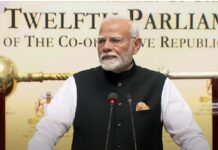Hypertension is a leading cause of stroke. It puts an extra strain on all the blood vessels in the body and makes them become stiffer and narrower. This can lead to clots forming and travelling to the brain, causing a stroke. The Department of Community Medicine and School of Public Health, PGIMER, Chandigarh is implementing a project entitled, ‘Strengthening the management of hypertension services through capacity building, media and communication and stakeholder’s engagement in the state of Punjab’ with an aim to strengthen the prevention and management of hypertension services.
Dr. Sonu Goel, Principal Investigator of the project, Professor, Department of Community Medicine and School of Public Health, PGIMER, Chandigarh is working closely with the Government of Punjab on Hypertension and its related factors. Dr. Goel added, “Uncontrolled raised blood pressure and/or hypertension can cause stroke, myocardial infarction, cardiac failure, renal failure, blindness, etc. Tackling hypertension will avert many noncommunicable diseases, disabilities, and deaths.” He also mentioned that through this project, the eminent experts from various fields are being invited to answer the frequently asked questions on hypertension and other comorbid conditions. Dr. Dheeraj Khurana, Professor, Department of Neurology has answered the FAQs on ‘Hypertension and Stroke’
Dr. Dheeraj Khurana
Professor in the Department of Neurology, PGIMER Chandigarh
Q1. What is stroke?
Stroke or a brain attack is a condition of the brain which occurs when either the blood flow to a part of the brain gets blocked in a blood vessel or there is an excess blood flow due to bursting of a blood vessel. Both the conditions cause permanent damage to the brain leading to a paralysis of one half of the body and face severe disability.
Q2. How hypertension is related to stroke? Kindly explain the pathophysiology in simpler terms.
Hypertension is the commonest risk factor for stroke. By risk factor, we mean that uncontrolled, this can lead to the conditions which cause a stroke. In the case of stroke, poorly controlled hypertension leads to build up of cholesterol plaque in the arteries which can further block a blood vessel. On the other extreme, a very high blood pressure can cause the artery to burst and cause bleeding in the brain.
Q3. Could you please share some recent statistics/data on hypertension as a complication for stroke?
A standardized case-control study (INTERSTROKE) was conducted in 32 countries from March 2007 to September 2015, comprising 26,945 participants from 32 countries, with 13,462 individuals having acute first-ever stroke (cases) and 13,483 controls. It was reported that hypertension is an important modifiable risk factor for stroke. Untreated hypertension was associated with a higher OR for stroke (OR 5.25; 4.53 to 6.10) than treated hypertension (OR 2.60; 2.32 to 2.91). Younger age of first stroke (61.4 vs 65.4 years; p<0.01) and deficits in knowledge, detection and treatment of hypertension contribute to higher risk of stroke in lower-income countries.
https://heart.bmj.com/content/heartjnl/107/4/282.full.pdf
Q4. How can a patient diagnose stroke? What are its early signs and symptoms?
The easiest way to diagnose a stroke is to remember the acronym FAST: F for face – is there is any weakness of the face, A for arms- is there any weakness of arms, S for speech: is there any difficulty in speaking, T for Time- Do not lose time, rush to the hospital.
The most important thing is to reach the nearest hospital at the earliest as strokes can be treated best within the first 4.5 hours of the attack.
Q5. As PGIMER is a tertiary care institute, what kind of patients do you come across in your routine practice? How do you manage them?
We usually get all types of stroke cases and even young patients with strokes. Although strokes due to blocked vessels (ischemic) are commoner, strokes due to bleeding in the brain (hemorrhagic) are also seen in large numbers. Most strokes arrive at a later window period to the emergency. We currently also get strokes referred from the other hospitals (GMSH-16 and Sector-32 GMCH) .
Q6. We would like you to inform the general public regarding the existing services or initiatives being undertaken by the Department of Neurology.
We have a very active stroke program with a 24X7 availability of acute stroke services and stroke treatments can be given up to 24 hours of the stroke as we also have the facility of neuro-intervention (in collaboration with the department of Radiodiagnosis). Apart from this, there is also a special stroke clinic which has been started recently in the OPD block which is run twice a month on Thursdays. The clinic will be offering a comprehensive care for stroke management which will include secondary prevention and rehabilitation.
Q7. List the measures which a common person should adopt to prevent stroke.
The most important measure is control of major risk factors like hypertension, diabetes, obesity and high cholesterol. Other risk factors like smoking, alcohol, lack of exercise should also be appropriately managed. In general, a healthy diet consisting of fresh fruits and vegetables and regular exercise (at least 3 times a week of strenuous work out) is recommended.
Q8. During these COVID times, do you recommend any special precaution for the vulnerable population.
Most importantly, the general public should not ignore symptoms of brain attack and should reach the hospital immediately if they experience any of these symptoms. They should not wait and stay back at home.
Everyone must also follow the general guidelines and precautions, especially masking. It is strongly advised that all the medications which are being taken for underlying disorders like hypertension, diabetes, heart diseases, etc. should be regularly continued and the public should take the COVID vaccination as and when available.
Q9. Any key message you want to give to the public.
Be aware of your risk factors; eat healthy and exercise regularly. Quit smoking and limit alcohol and stay away from drugs; Learn to recognize a stroke (remember FAST) and if you see anyone who may be having a stroke, take them to the nearest hospital where there is availability of stroke treatment
Q10. Punjab is one of the states in India having a very high prevalence of hypertension. The Department of Community Medicine and School of Public Health is running a project to strengthen the hypertension management services in the state of Punjab. How do you think this ongoing project is useful for the general community?
As hypertension is one of the biggest killers and is a silent killer as it causes significant burden of heart attacks and stroke, this program will be highly beneficial in making headways in reducing the burden of these major NCDs which are also leading causes of death in our country.
















